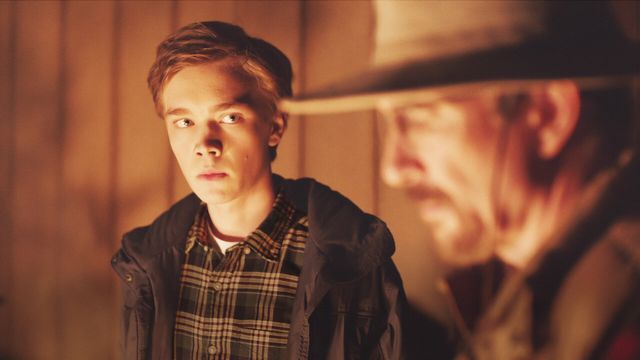The Clovehitch Killer, a mystery movie directed by Duncan Skiles, stands out from other films about serial killers because it approaches the topic in a novel way. The movie exposes the intimate lives of a serial killer by following Tyler Burnside, a teenager, on his tumultuous journey to learn his father’s true identity.
Since most serial killer movies are based on actual criminals, you might be wondering how much of this movie is based on fact. Let’s save you the trouble of wondering if the movie’s famous Clovehitch Killer is based on a genuine person from the police files. All the information you require is here!
Is There a True Story Behind The Clovehitch Killer?
A portion of “The Clovehitch Killer” is based on factual events. Dennis Rader, the infamous real-life murderer known as the BTK killer, served as the model for the movie’s title serial killer. The Stephen King novella “A Good Marriage” from 2010 is arguably the most notable of the numerous fictional works that have been inspired by the BTK killer.
Katherine Ramsland’s 2016 nonfiction book “Confession of a Serial Killer: The Untold Story of Dennis Rader, the BTK Killer” also discusses the BTS killer.
In order to create the enigmatic character of Donald Burnside, the director of the Duncan Skiles film, Dennis Rader, did a great deal of research on his personality. He then assigned Christopher Ford, who also wrote the screenplay for “Spider-Man: Homecoming,” the task of creating the script.
Films like “The Vanishing” and “Stranger by the Lake,” as well as Hitchcock classics like “Shadow of a Doubt” and Michael Haneke’s “Funny Games,” served as inspiration for the director’s style. It seems sense that “The Clovehitch Killer” draws inspiration from these masterpieces for its gloomy, slow-burning, and minimalist atmosphere—as well as its dearth of music.
However, it appears that there are clear similarities between the murderer in the movie and the actual acts that the BTK Killer committed. The guy in question, Dennis Rader, was born in Pittsburg, Kansas, in 1945 into a middle-class family.
Despite having the characteristics of a serial killer dormant in him from a young age, Rader, the eldest of four siblings, apparently lived a typical childhood. He would occasionally stop tormenting and killing stray animals. After a year at Kansas Wesleyan University, Rader left to enlist in the United States Air Force, where he served from 1966 to 1970.
There’s more to discover if the sinister parallels between “The Clovehitch Killer” and the actual BTK killer pique your interest. For in-depth essays, analysis, and updates on the newest true crime movies, visit Editorials24. Join us as we explore the world of mystery and suspense in greater detail!
After getting married in 1971, Dennis started working for ADT Security Services. He attended Wichita State University in the interim and earned a Bachelor of Science degree with a major in Administration of Justice in 1979.

started Dennis Rader’s murderous rampage after establishing a decent family and community life. He would have killed ten innocent victims—all women—by the time he was apprehended in 2005. Similar to the character in the movie, Dennis Rader would also do autoerotic asphyxiation.
In addition, the killings would be blatantly sexual, earning him the moniker BTK Killer (bind, torture, and kill). From the crime site, the police even discovered semen traces. Rader acknowledged that the act of killing gave him sexual pleasure.
Also Read: https://editorials24.com/2024/09/is-the-movie-the-veil-based-on-a-true-story/
Before killing his victims, the Clovehitch Killer is shown in the movie torturing and binding them. He targets women as well, and it appears that he gets a sexual kick out of attacking them. Since the Clovehitch Killer is shown spying on ladies before murdering them, his method of operation is likewise comparable to that of the BTK killer.
Furthermore, the BTK Killer remained undiscovered for nearly ten years, from 1977 to 1985, before killing someone again, just like the Clovehitch Killer in the movie.
Like the Clovehitch Killer, who ties a clove hitch close to the crime scene, the BTK Killer was also well-known for teasing the authorities by leaving clues at the scene. But the most obvious resemblance between the fictitious Clovehitch Killer and the real-life BTK Killer is that both led apparently respectable and typical lives in their families and communities.
The most shocking revelation regarding the BTK Killer was that he pursued his sadistic and unsettling dreams while doing a full-time job, taking care of his family, and hiding beneath the radar of a tiny town.
The BTK Killer served as both the local church council president and a scoutmaster, just like the character in the movie. The Clovehitch Killer appears to be living a happy life; he is portrayed in the movie as a loving husband and father.
Dennis has two children, a younger daughter and an older son, just like Don in the movie. The film’s conclusion, however, departs from the true narrative in order to increase the viewer’s cathartic experience.
While the Clovehitch Killer was apprehended by his own kid, the BTK Killer was apprehended based on the clues he supplied to the police authorities.
The film does not adopt a first-person perspective or the police narrative, in contrast to earlier accounts of the BTK Killer. It creates an expression of familial disjunction by turning the narrative inward.
The narrative is told from Tyler’s point of view, and because of his father’s pervasive influence, his perception of him is never entirely impartial. The story has a strong sense of dread and anxiety because of the director’s position.
As it delves deeper into the serial killer’s private life, the fiction ultimately gets more graphic than reality. The story is given a feeling of poetic justice by the killer’s eventual death at the hands of his own son, but unlike the BTK Killer, the Clovehitch Killer’s true name is never revealed.
